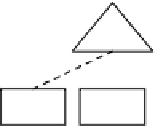Information Technology Reference
In-Depth Information
VP
vp
1
V
V
V
v
1
v
2
v
3
State
Label
(EX f
1
, v
1
)
(EX f
1
, v
1
)
Z
0
z
1
z
2
z
3
Z
1
f
1
a!
b!
c!
Z
2
f
1
Z
3
¬
f
1
z
0
Fig. 3
Example of checking the completeness of witnesses
assume that
EX f
1
is a common property, i.e. it has to be fulfilled by every possible
product. The initial state
z
0
is labeled with two labels for
EX f
1
, one for the variant
v
1
and one for the variant
v
2
, i.e. there are witnesses for
EX f
1
. However, this set of
witnesses is not complete. The orthogonal variability model on the left hand side in
variants has to be selected. Therefore, it is possible to derive a product which only
contains the variant
v
3
and for this product, there is no witness for
EX f
1
since it is
impossible to reach a state from
z
0
that is labeled with
f
1
.
6 Conclusion
In this chapter, we outlined different strategies for assuring the quality of domain
artifacts in software product line engineering. It has been observed that a central
challenge for the quality assurance of domain artifacts is the variability of these
artifacts. The variability prevents the direct application of quality assurance tech-
niques from single-system engineering, since these approaches do not consider the
variability of the product line. A common strategy for dealing with the variability
is the derivation and quality assurance of sample products with single system tech-
niques. However, the success of this sample strategy mainly depends on the quality
of the selected sample products; e.g. they must be representative for all the products.
A complete coverage of the product line is thus hard to guarantee in general.
As an alternative, we presented a quality assurance approach that allows a com-
prehensive verification of domain artifacts and guarantees that all products of the
product line provide the specified properties. The approach is based on model
checking techniques and considers the variability of the domain artifacts during the
verification process, thereby eliminating the need to costly check each product of
the product line individually.










Search WWH ::

Custom Search